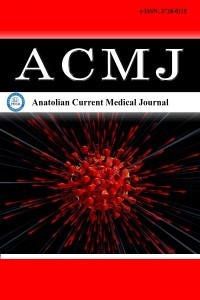1.
Capizzi A, Woo J, Verduzco-Gutierrez M. Traumatic brain injury: an overview of epidemiology, pathophysiology, and medical management. <em>Med Clin North Am.</em> 2020;104(2):213-238.
2.
Lui A, Kumar KK, Grant GA. Management of severe traumatic brain injury in pediatric patients. <em>Front Toxicol</em>. 2022;4:910972.
3.
Sabouri E, Majdi A, Jangjui P, Rahigh Aghsan S, Naseri Alavi SA. Neutrophil-to-lymphocyte ratio and traumatic brain injury: a review study. <em>World Neurosurg</em>. 2020;140:142-147.
4.
Ray S, Luke J, Kreitzer N. Patient-centered mild traumatic brain injury interventions in the emergency department. <em>Am J Emerg Med</em>. 2024;79:183-191.
5.
H Hopman J, A L Santing J, A Foks K, et al. Biomarker S100B in plasma a screening tool for mild traumatic brain injury in an emergency department. <em>Brain Inj</em>. 2023;37(1):47-53.
6.
Vos PE, Alekseenko Y, Battistin L, et al. Mild traumatic brain injury: mild traumatic brain injury.<em>Eur J Neurol</em>. 2012;19(2):191-198.
7.
Miyagawa T, Saga M, Sasaki M, Shimizu M, Yamaura A. Statistical and machine learning approaches to predict the necessity for computed tomography in children with mild traumatic brain injury.<em>Plos one</em>.2023;18(1):e0278562
8.
Pearce MS, Salotti JA, Little MP, et al. Radiation exposure from CT scans in childhood and subsequent risk of leukaemia and brain tumours: a retrospective cohort study.<em>Lancet.</em> 2012;380:499-505.
9.
Torabi M, Amiri ZS, Mirzaee M. Blood glucose level as a predictor of abnormal brain computed tomography scan findings in patients with mild traumatic brain injury. <em>Bull Emerg Trauma.</em> 2023;11(2):83-89.
10.
Schwulst S.J., Trahanas D.M., Saber R. Traumatic brain injury-induced alterations peripheral immunity.<em>JTrauma Acute Care Surg</em>.2013;75(5):780-788.
11.
Xiong Y, Mahmood A, Chopp M. Current understanding of neuroinflammation after traumatic brain injury and cell-based therapeutic opportunities. <em>Chin J Traumatol.</em> 2018;21(3):137-151.
12.
Werner JK, Stevens RD. Traumatic brain injury: recent advances in plasticity and regeneration<em>. Curr Opin Neurol</em> 2015;28(6):565-573.
13.
Kusuma GFP, Maliawan S, Mahadewa TGB, Senapathi TGA, Lestari AAW, Muliarta IM. Neutrophil-to-lymphocyte ratio and platelet-to-lymphocyte ratio correlations with C-reactive protein and erythrocyte sedimentation rate in traumatic brain injury. <em>Maced J Med Sci.</em> 2020;8(B):1185-1192.
14.
Wang R, He M, Zhang J, Wang S, Xu J. A prognostic model incorporating red cell distribution width to platelet ratio for patients with traumatic brain injury. <em>Ther Clin Risk Manag.</em> 2021; 17:1239-1248.
15.
Reinus WR, Wippold FJ, Erickson KK.Practical selection criteria for noncontrast cranial computed tomography in patients with head trauma.<em>Ann Emerg Med</em>. 1993;22(7):1148-1155.
16.
Alexiou GA, Lianos GD, Tzima A, et al. Neutrophil to lymphocyte ratio as a predictive biomarker for computed tomographyscan use in mild traumatic brain injury. <em>Biomark Med.</em> 2020;14(12):1085-1090.
17.
Kalra S, Malik R, Singh G, et al. Pathogenesis and management of traumatic brain injury (TBI): role of neuroinflammation and anti-inflammatory drugs. <em>Inflammopharmacology.</em> 2022;30(4):1153-1166.
18.
Mishra RK, Galwankar S, Gerber J, et al. Neutrophil-lymphocyte ratio as a predictor of outcome following traumatic brain injury: systematic review and meta-analysis. <em>J Neurosci Rural Pract</em>. 2022; 13(4):618-635.
19.
Defort P, Retkowska-Tomaszewska N, Kot M, et al. Inflammatory predictors of prognosis in patients with traumatic cerebral haemorrhage: retrospective study. <em>J Clin Med</em>. 2022;11(3):705.
20.
Buonacera A, Stancanelli B, Colaci M, Malatino L. Neutrophil to lymphocyte ratio: an emerging marker of the relationships between the immune system and diseases. <em>Int J Mol Sci</em>. 2022;23(7):3636.
21.
Corbett JM, Ho KM, Honeybul S. Prognostic significance of abnormal hematological parameters in severe traumatic brain injury requiring decompressive craniectomy. <em>J</em> <em>Neurosurg</em>. 2019; 132(2):545-551.
22.
Siwicka-Gieroba D, Malodobry K, Biernawska J, et al. The neutrophil/lymphocyte count ratio predicts mortality in severe traumatic brain injury patients. J Clin Med. 2019;8(9):1453.
23.
Chen W, Yang J, Li B, et al. Neutrophil to lymphocyte ratio as a novel predictor of outcome in patients with severe traumatic brain injury. <em>J Head Trauma Rehabil</em>. 2018;33(1):E53-E59.
24.
Zhao JL, Du ZY, Yuan Q, et al. Prognostic value of neutrophil-to-lymphocyte ratio in predicting the 6-month outcome of patients with traumatic brain injury: a retrospective study. <em>World Neurosurg</em>. 2019;124: e411-e416.
25.
Xie QJ, Huang W, Shen L, Wang MH, Liu KF, Liu F. Combination of neutrophil-to-lymphocyte ratio and admission glasgow coma scale score is independent predictor of clinical outcome in diffuse axonal injury. <em>World Neurosurg</em>. 2021;152:e118-e127.
26.
Acar E, Demir A, Alatas Ö, et al. Evaluation of hematological markers in minor head trauma in the emergency room. <em>Eur J Trauma Emerg Sur</em>. 2016;42(5):611-616.
27.
Li W, Deng W. Platelet-to-lymphocyte ratio predicts short-term mortality in patients with moderate to severe traumatic brain injury. <em>Sci Rep</em>. 2022;12(1):13976.
28.
Tao C, Wang J, Hu X, et al. Clinical value of neutrophil to lymphocyte and platelet to lymphocyte ratio after aneurysmal subarachnoid hemorrhage. <em>Neurocrit Care</em>. 2017;26(3):393-401.
29.
Siempis T, Georgalis PA, Lianos G, et al. Blood biomarkers for prediction of positive CT findings in mild traumatic brain injury in paediatric population. <em>J Integr Neurosci.</em> 2023;22(4):91.

